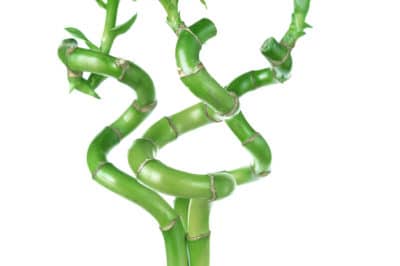Lucky Bamboo vs. True Bamboo
Although the plants resemble each other, lucky bamboo and true bamboo are very different. Lucky bamboo has a much more limited outdoor range and true bamboo doesn’t do well indoors. Lucky bamboo’s stems are solid, while true bamboo has hollow stems. However, both can be propagated from cuttings made from the stems.
A Health Indicator
Aside from other qualities, the stems of lucky bamboo provide an indicator of the plant’s health. Yellow leaves can be a minor problem indicating too much sunlight or fertilizer. Once the stems begin to yellow, however, it is more likely to indicate contaminated water causing an infection. If you catch it early enough, you can cut off the top of the plant and regrow what’s left.
Shaping Lucky Bamboo Stalks
Commercial lucky bamboo is often professionally shaped. The plant may be twisted, braided or shaped into something like a heart or spirals. Intricately shaped lucky bamboos often include as many as twenty different plants or stalks in a single pot. They may be adorned with colorful thread or ribbon. These kinds of lucky bamboo are very expensive.
Feng Shui and Stalks
The art of feng shui includes rules on what the number of stalks mean. Among these:
- Three and seven are important numbers; they may represent good health, happiness, wealth and long life.
- Five stalks represent life areas such as spirit, emotions and intuition.
- Nine stalks mean a wish for great luck.
- Twenty-one stalks – three times seven – indicates a powerful blessing is being bestowed.
How Lucky Bamboo Grows
Lucky bamboo grows one section at a time. Each section of stem is punctuated by whorls where leaves arise. As the stalk becomes longer, the leaves start to drop off – or commercial growers deliberately cut them off – to produce the typical jointed stem appearance. This is what makes the plant look so much like true bamboo. In the wild, the plant would look much bushier.
Creating Spirals
Lucky bamboo stems can be manipulated into a spiral. Find a cardboard box slightly bigger and taller than your plant; cut off one side and the bottom. Place the open side facing your light source. As the plant grows toward the light, creating a bend, rotate the plant container slightly. Repeat until you have one or more spirals.
